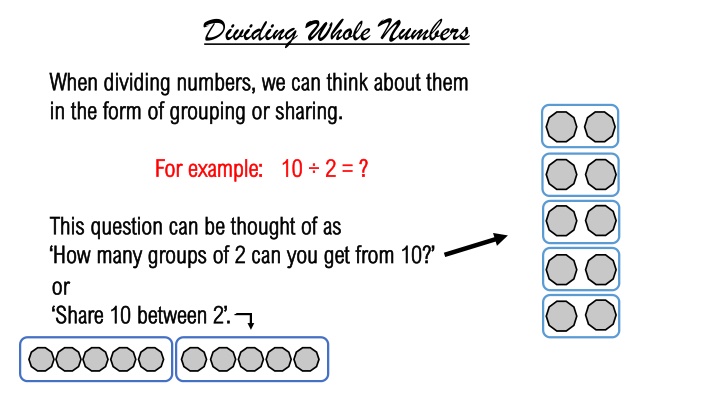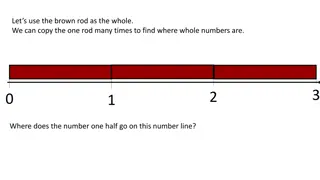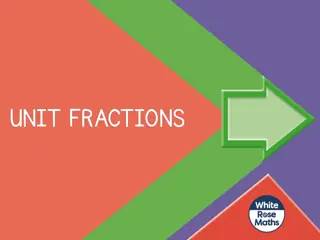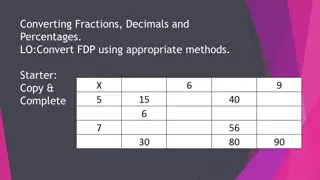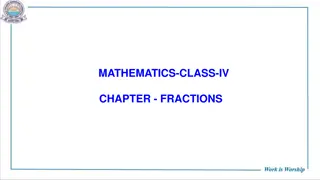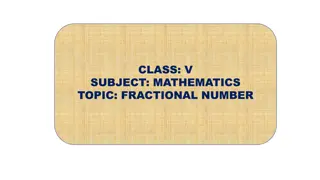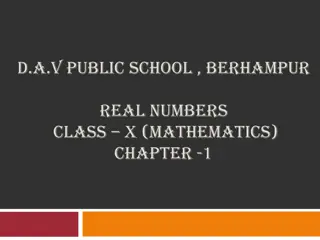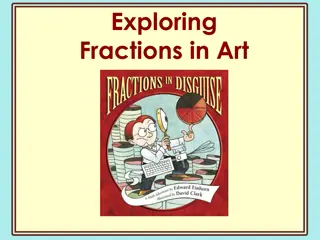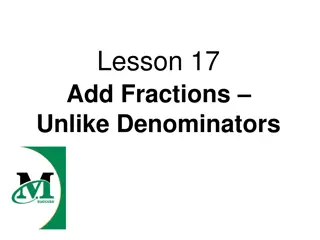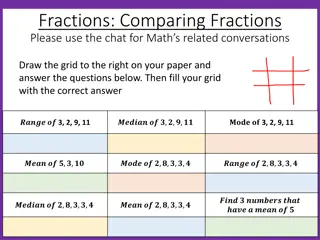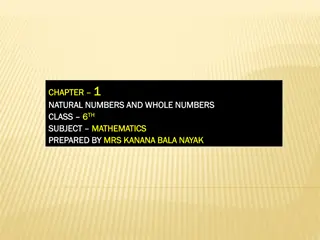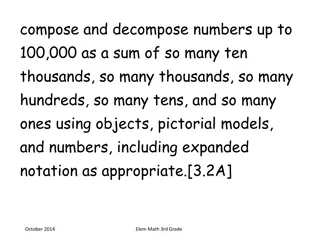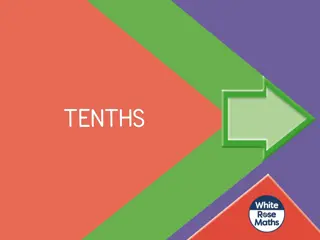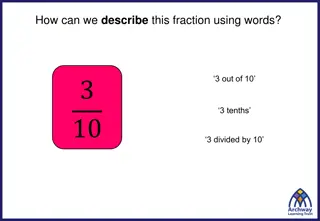Dividing Whole Numbers & Fractions: Understanding Mathematical Concepts
Here, we explore the concept of dividing whole numbers and fractions through grouping, sharing, and visual representations. We delve into dividing whole numbers, understanding equivalent fractions, and utilizing diagrams to solve division problems with different denominators. The content provides examples, illustrations, and reasoning exercises to enhance understanding.
Download Presentation

Please find below an Image/Link to download the presentation.
The content on the website is provided AS IS for your information and personal use only. It may not be sold, licensed, or shared on other websites without obtaining consent from the author.If you encounter any issues during the download, it is possible that the publisher has removed the file from their server.
You are allowed to download the files provided on this website for personal or commercial use, subject to the condition that they are used lawfully. All files are the property of their respective owners.
The content on the website is provided AS IS for your information and personal use only. It may not be sold, licensed, or shared on other websites without obtaining consent from the author.
E N D
Presentation Transcript
Dividing Whole Numbers When dividing numbers, we can think about them When dividing numbers, we can think about them in the form of grouping or sharing. in the form of grouping or sharing. For example: 10 For example: 10 2 = ? 2 = ? This question can be thought of as This question can be thought of as How many groups of 2 can you get from 10? How many groups of 2 can you get from 10? or or Share 10 between 2 . Share 10 between 2 .
What about 4 What about 4 ? ? = ? = ? Thinking: How many Thinking: How many 1 2 ? can I get from 4? can I get from 4? 4 4 ? ? = = 8 8 1 2 4 From the diagram you can see that From the diagram you can see that 8 8 halves make 4. halves make 4.
Try these: Try these: 6 halves 6 halves 1) 1) 3 3 ? 6 6 ? = = 2) 2) 5 5 ? ? = = 10 10 10 halves 10 halves 3) 3) 7 7 ? 21 21 ? = = 21 thirds 21 thirds 4) 4) 2 2 ? 8 8 ? = = 8 quarters 8 quarters
Thinking/Reasoning Thinking/Reasoning 1) 1) 3 3 ? 6 2 1 ? = = 6 6 6 6 6 1 = 6 1 ( The 6 and 1 are the numerators) 6 1 2 = 2) 2) 5 5 ? 10 2 1 ? = = 10 10 10 10 10 1 2 = Identify the Identify the equivalent fraction equivalent fraction using the same using the same denominator. denominator. 3) 3) 7 7 ? 21 3 1 21 21 21 21 ? = = 3 = 21 1 4) 4) 2 2 ? 8 4 1 ? = = 8 8 8 8 4 = 8 1
Dividing Fractions How would you use the diagrams to How would you use the diagrams to answer the question: answer the question: ? ? ? ?= ? ? ? ? 1 1 From the diagram you can see that ONE red shaded part FITS into the blue shaded part. ?= Thinking: Thinking: ? s can I get from ? ? 1 2 How many How many ? s can I get from ? One One ? ? ? ? ? ? 1 1 = 1 because because 1 1 ?=
Another example: How would you use the diagrams to How would you use the diagrams to answer the question: answer the question: ? ? ? = ? = ? ? ? ? ? ? ? ?= From the diagram you can see that HALF the brown shaded part FITS into the yellow shaded part. Thinking: Thinking: ? s can I get from How many How many ? s can I get from ? Half Half ? ? ? ? ? 1 3
So far the denominators have been the same. So far the denominators have been the same. What will happen when the denominators are different? What will happen when the denominators are different? Thinking: Thinking: ? s can I get from ? ? ? ? ? Five sixths Five sixths How many How many ? s can I get from ? ?= ? ? ? How would you use diagrams to answer How would you use diagrams to answer this question? this question? First find the equivalent fraction, using the First find the equivalent fraction, using the common multiple as the denominator: common multiple as the denominator: ? ?= ? ?? ?? , , ? ? ??= ? ? ? ?= ? ?? ?? ? ? ? ?= ? ?? ?= So, So,
Independent activity Independent activity Use Use diagrams/equivalence diagrams/equivalence to answer these: to answer these: 3 3 1)3 4 3 1 4 = 2) 1 3 1 4 3 4 = 3) 1 4 2 5 8 5 = 3 5 6 10 4) 2 5 2 3 = 5 6 5) 1 2 3 5 =
What is the rule for dividing fractions? 3 4 3 = 3 ? 8 4 ? 3 = 24 12 = 2 3 4 x 8 3 8 = 1. Keep the first fraction (the dividend); 2. Change the to X; 3. Turn the second fraction (the divisor) upside down (invert it). 4. Apply rules of multiplying fractions. Do you get the same answer using the Do you get the same answer using the diagrammatic method? Show how. diagrammatic method? Show how.
Challenge 5: True or False Show your working to explain your choice of answer. Try these questions. (Answer using diagrams/written method) Challenge 1: Challenge 2: 1) 3 1 Challenge 3: Challenge 4: 1 6 13 2 5 2 1 2 5 1) 4 = 5 = 1) 3 = 1) 7 = 2) 6 2 2) 31 3 2 4 12 2 1 3 2 5 = 6 = 2) 3 = 2) 5 = 1 3 2 6 = 2 1) 9 3 8 5 = 3) 25 3 4 3 1 4 2 3) 8 5 = 3) 8 = 3) 6 = 5 8 2 5= 9 2) 16 2 5 7= 4) 12 5 31 4 5 6 1 5 6 4) 4= 4) 7 = 4) 9 = 9 6 3 5 = 2 3 3) 6 3 10 22 11 3 9 5) Where possible, simplify your answers. 1 10 3 12 = 5) 2 6) Where possible, simplify your answers. 9 = 5) 6) Where possible, simplify your answers. 4 = 5) 6) Where possible, simplify your answers. 4) 22 3 2 3= 4 5) 13 5 22 5 = 3 1 4
Solutions Challenge 1: Challenge 3: 1) 3 1 Challenge 4: Challenge 2: Challenge 5: 1 6 13 5 = 5 2 5 2 3 = 6 1 3 2 6 = 2 1 2 5 7 = 7 4 = 12 1) 1) 1) 9 False 1) 10 48 10 2) 6 2 5 = 30 2) 31 3 2 6 = 60 4 12 2 3 = 12 5 8 2 5= 9 2 1 3 2 5 = 5 2) 2) 16 False 2) 6 24 6 3 8 5 = 3 3) 25 8 5 = 21 3 4 3 8 = 24 9 6 3 5 = 2 3 3) 1 4 2 6 = 6 3) 3) 6 True 3) 40 40 12 8 2 5 7= 2 4) 12 5 31 4= 28 4 5 6 7 = 28 4) 22 3 2 4) 1 5 6 9 = 9 4) 3= 4 True 4) 30 35 65 30 3 10 22 9 = 207 11 3 9 4 = 36 5) 13 5 22 False 5 = 3 1 1 10 3 12 = 12 5) 2 5) 4 5) 200 33 30 All answers marked in red can be simplified.
Plenary Is this statement True or False? Is this statement True or False? Why? Why? ? ? ? ? = = ? ? ? ?
